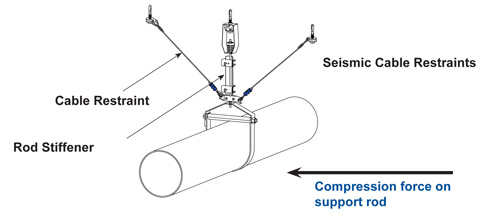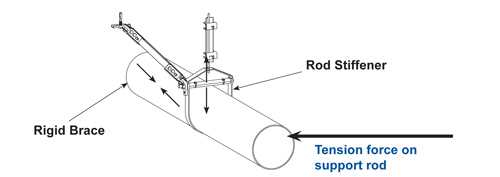Understanding Seismic and Wind Restraints
Transverse and Longitudinal Restraints
There are two basic types of restraints:
- Transverse (T) restraints, which act perpendicular to the pipe.
- Longitudinal restraints (L), which act along the pipe.
Transverse and longitudinal restraints may be placed at the same location and designated (TL).
Transverse restraints may be either cables or struts. Although they look similar, they behave very differently in practice. Cables carry only tension loads (cables cannot be pushed). Struts carry both tension and compression loads.
In general, piping restrained by struts will require one strut for each type of restraint at each location. Since they can be fitted to one side only, struts allow for a more narrow packaging arrangement.
Piping restrained with cables may take up more space than is available. Cable restraint requires that two cables be fitted 180° apart for each type of restraint at each location.
The cable or strut restraint installation angle may be between 0° and 60° as measured from the horizontal.
Because struts subject hanger rods to tensile loads in conjunction with the static weight loads, the number of restraint points needed on a given run of piping will typically be considerably higher for a strut-restrained system than for the cable-restrained system. In addition, the use of struts subjects the anchorage for the hangers at the strut locations to become part of the seismic restraint system; this means that the struts will need to be fitted with seismically rated anchors. The net result is that strut-restrained systems will be more costly to install.
An added factor to consider when selecting a restraint system is that once a decision is reached on the type to use for a particular run, code requirements state that the same type of system must be used for the entire run (all cable or all strut).
 |
 |
Struts are loaded in compression, which makes the hanger rod part of the seismic load path. Cables can only be loaded in tension, which means the hanger rod and its anchorage are not part of the seismic load path. Images courtesy of Kinetics Noise Control |
Seismic forces load the strut in compression resulting in a tensile load on the hanger rod. This results in the hanger rod and its anchorage becoming part of the seismic restraint load path. The hanger rod must, therefore, be installed using a seismically rated anchor that includes such requirements as use of wedge-type anchors and minimum embedment depths (mentioned above).
Cables, on the other hand, can only be loaded in tension, which, means that seismic forces can only generate compressive loads in the pipe hanger rod and its anchorage, which are not part of the seismic load path. The hanger rod in this case do not require a seismically rated anchor at hanger support locations. Straps and cables may not be used as hangers at restraint locations.
Transverse and longitudinal restraints must be placed within 4 inches of a hanger location. This will ensure that the vertical reactions are transmitted to the hangers rather than bending the pipe or duct. The hanger itself at restraint locations must be a rigid member capable of carrying compression loads.
 |
Restraint requirements for vertical drops depend on H (horizontal run) and S (transverse restraint spacing). Image courtesy of Kinetics Noise Control |









